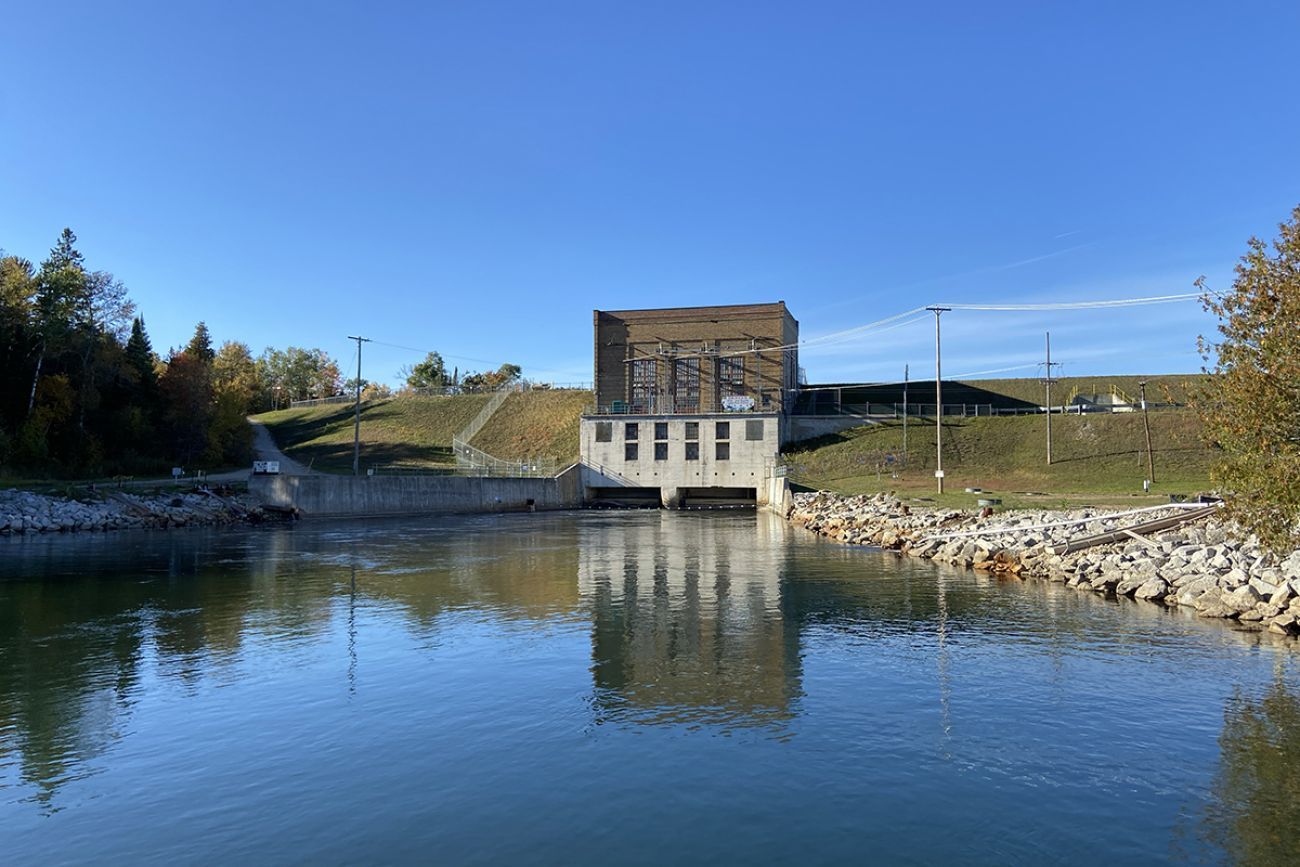As Consumers mulls selling 13 dams, some in Michigan fear another disaster

- Consumers Energy’s 13 hydroelectric dams produce little energy, at nine times the price of other sources
- As a result, the company is mulling the possibility of selling the dams
- But some are raising alarm, citing a long history of companies offloading unwanted dams onto owners who can’t afford them, shifting risks and costs onto the public
As it considers the future of 13 hydropower dams that provide little electricity while operating at a $152 million annual net loss, one of Michigan’s largest utilities is considering selling them for as little as a dollar apiece.
Such a deal would be ideal for Consumers Energy, freeing the company and its 1.8 million ratepayers from a financial burden, while avoiding the contentious prospect of demolishing dams whose vast reservoirs have become popular recreational lakes.
But as the company privately vets prospective buyers, dam safety advocates and environmentalists who favor dam removal are raising alarm about the possible downsides.
Namely, a long history of companies offloading unprofitable dams onto new owners who can’t afford their costly upkeep, eventually leaving Michigan taxpayers to pick up the bill — or pick up the pieces when a dam fails.
The most notorious examples are the Edenville and Sanford dams near Midland, which changed hands repeatedly as owners failed to make safety upgrades.
Finally, in 2020, the decrepit dams failed, flooding out mid-Michigan and causing $200 million in property damage. Their owner, Boyce Hydro LLC, declared bankruptcy, and taxpayers have so far shelled out $200 million to rebuild the dams, plus tens of millions more to clean up after the disaster.
Related:
- Uncertainty for Michigan rivers, residents as Consumers reconsiders its 13 dams
- Two heirs bought Midland dams as a tax shelter. Tragedy followed.
- Two years after Midland dam failures, still no action on safety reforms
- Consumers Energy tells Michigan residents it needs partners to keep hydro dams
“(Consumers) should know that this has turned out bad in the past,” said Bryan Burroughs, Michigan Trout Unlimited executive director. “And instead they’re encouragingly talking about a scenario that could set up a bunch more Midlands on us.”

Company officials note that they still haven’t decided whether to keep, sell, or demolish the dams. And they say safety is a priority as they vet prospective buyers.
“All three options are still on the table,” said Angela Thompkins, Consumers’ chief diversity officer and vice president of community affairs, adding that “we want to make sure that we're doing the right thing for the company, for investors, the customers and the community.”
Fans of the dams say they trust Consumers to find a good buyer. And for them, any trepidation about new owners is eclipsed by fear that Consumers could demolish the dams and turn the reservoirs back into free-flowing rivers.
“Everyone wants to see the status quo,” said state Sen. Michele Hoitenga, R-Manton, whose district includes eight of the dams. “Obviously, we know that isn't working for Consumers.”
Bad financial math
Consumers once owned more than 90 hydropower dams across Michigan, but has been exiting the business for decades as ballooning maintenance costs, new regulations and competition from cheaper energy sources make hydropower unprofitable.
Today, just 13 dams remain in the company’s portfolio — and they’re among the biggest and most well-known in Michigan. The impoundments in the Au Sable, Manistee, Muskegon, Grand and Kalamazoo rivers average more than a century old and generate just 1% of the company’s electricity, at nine times the cost of any other power source.
In light of that bad financial math, Consumers has spent the past two years mulling whether it wants to keep, sell, or decommission the structures. Spokesperson Tracy Wimmer said a decision is expected in early 2025.
All three options are potentially controversial:
- Keeping the dams would mean higher energy costs for the utility’s customers, costing them a collective $781 million more than dam removal.
- Decommissioning the dams would please river advocates, who loathe how they superheat rivers and destroy fish habitat. But it would anger the owners of lakefront properties created by the dams, and transform communities that have built their economies around fishing and boating tourism.
- And selling the structures raises questions about how a new owner could squeeze enough profit out of their meager hydropower to cover the massive maintenance costs.
Consumers announced its search for potential buyers last year. Fifteen North American companies have submitted viable proposals, according to notes from the company’s meetings with local interest groups.
Consumers hopes one of them will purchase all 13 dams, then sell the hydropower back to Consumers on a 30-year contract. An instruction sheet for prospective buyers offers a selling price of as little as $1 per dam.
“The goal is to identify a partner that has the expertise, financial capability, and desire to own, operate and care for the facilities over the long term,” the document states.

Ignored calls for reforms
Hoitenga, the Manton lawmaker, said she trusts Consumers to seek out only responsible buyers.
“I am pretty confident in them, that they wouldn't sell (the dams) to somebody who wouldn’t be able to maintain them,” Hoitenga said.
But Burroughs is skeptical.
If operating the dams isn’t financially feasible for Consumers, he wonders, how could another company make it work?
Monopoly utilities like Consumers have more financial incentive to maintain their infrastructure, because their captive ratepayers typically cover the cost, guaranteeing a profit.
That’s not true for private hydropower dam owners, which usually sell the electricity from their structures on the open market. Every dollar spent on maintenance is a dollar less in profits.
As a result, their dams are often poorly maintained.
U.S. Army Corps of Engineers data shows that all of Michigan’s 40 utility-owned dams with available inspection data are in fair or better condition. In contrast, 32 of 396 private dams are in poor or unsatisfactory condition.
Any attempt to sell the Consumers dams would need to go through state and federal energy regulators, who have the power to reject a proposed sale or operating license transfer.
But neither Michigan nor the U.S. government require dam owners to prove they can afford to maintain the structures they buy.
The Federal Energy Regulatory Commission (FERC), which regulates hydropower dams, has spent three-and-a-half years pondering whether to enact such a policy. At the state level, lawmakers have declined to update the weak dam safety laws since the Midland disaster.
In a 2022 letter to FERC, Michigan’s top dam safety official, Luke Trumble, urged the agency to require financial assurances from dam owners, calling it a matter “of grave importance to the state of Michigan.”
Trumble went on to cite Michigan companies’ long history of offloading unprofitable dams onto new owners who can’t afford to maintain them. Examples abound across the state, from the Peninsular Paper Dam in Ypsilanti, to the Rugg Pond Dam near Kalkaska.
“Long after all revenues have been extracted from the resources, the taxpayers are left with the burden of removing the dams,” Trumble wrote.
Given the gaps in financial oversight, the prospect of selling the Consumers dams “is fraught with red flags,” said Bob Stuber, executive director of the Michigan Hydro Relicensing Coalition.
“There is no incentive for a new owner to ever put a penny into these once they buy them,” Stuber said.
FERC spokesperson Mary O’Driscoll said the agency “cannot engage in any speculation” about how it would react to a proposal to sell the Consumers dams.
But O’Driscoll noted that when faced with license transfer requests, FERC officials consider whether the new operator “is capable of carrying out its responsibilities under the license to be transferred.”
Matt Helms, a spokesperson for the Michigan Public Service Commision, which regulates state utilities, declined to comment on how the agency would approach any review of Consumers’ preferred path forward.
No dam, no Mesick
In the tiny village of Mesick, 20 miles northwest of Cadillac on the Manistee River, Charlie Maidens has his own fears about the future.
He oversees the Northern Exposure campground, which leases land from Consumers along the Hodenpyl Dam Pond.
The nonprofit campground is an economic engine for the 400-person community: Its 260 sites are booked solid on summer weekends, and campers buy food, drinks, fishing tackle and gasoline at local businesses.
In Maidens’ ideal world, Consumers would stay in the hydropower business. But if that can’t happen, he said, he’d rather gamble on new owners than watch the Hodenpyl Dam disappear.
“Without the dam, there’s no Northern Exposure,” Maidens said. “If there’s no Northern Exposure, there’s no Mesick.”
Michigan Environment Watch
Michigan Environment Watch examines how public policy, industry, and other factors interact with the state’s trove of natural resources.
- See full coverage
- Subscribe
- Share tips and questions with Bridge environment reporter Kelly House
Michigan Environment Watch is made possible by generous financial support from:
Our generous Environment Watch underwriters encourage Bridge Michigan readers to also support civic journalism by becoming Bridge members. Please consider joining today.
See what new members are saying about why they donated to Bridge Michigan:
- “In order for this information to be accurate and unbiased it must be underwritten by its readers, not by special interests.” - Larry S.
- “Not many other media sources report on the topics Bridge does.” - Susan B.
- “Your journalism is outstanding and rare these days.” - Mark S.
If you want to ensure the future of nonpartisan, nonprofit Michigan journalism, please become a member today. You, too, will be asked why you donated and maybe we'll feature your quote next time!






